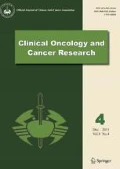Abstract
Objective
To investigate the expression of Coxsackie and Adenovirus receptor (CAR) in renal-cell carcinoma and the relationship of the CAR to the biological behavior of the carcinomas.
Methods
The immunohistochemical SP method was used to detect the expression of Coxsackie and Adenovirus receptor in 48 cases of renalcell carcinoma and in 12 cases of normal renal tissue 2 cm away from the tumor tissue.
Results
The positive rates of CAR were 100% in 12 cases of para-tu-mor normal renal tissue and 35.4% in 48 cases of renal-cell carcinoma respectively. The difference of CAR expression between them was significant (P<0.05). The grades of the tumor were as follows: 22 in Grade I, 17 in Grade II and 9 in Grade III with the CAR positive rate being 54.5%, 23.5% and 11.1%, respectively. There was a negative correlation between CAR expression and tumor grading (P<0.05). In addition, the number of the cases in stages I to IV were 19, 13, 11 and 5 respectively, with the respective positive rates being 57.9%, 30.8%, 18.2% and 0.0%, i.e. there also was a negative relationship between CAR expression and the stage (P<0.05).
Conclusion
CAR expression is down-regulated in renal-cell carcinoma compared with normal tissue. The level of CAR may be a sensitive predictor of differentiation, invasion and metastasis. Loss of CAR expression correlates with the invasive phenotype in our analysis of renal -cell carcinoma.
Similar content being viewed by others
References
Bergelson JM, Cunningham JA, Drouguett G, et al. Isolation of a common receptor for coxsackie B viruses and adenoviruses 2 and 5. Science. 1997; 275: 1320–1323.
Li Y, Pong RC, Hall MC, et al. Loss of adenoviral receptor expression in human bladder cancer cells: a potential impact on the efficacy of gene therapy. Cancer Res. 1999; 59: 325–330.
Cohen CJ, Shieh JT, Pickles RJ, et al. The coxsackievirus and adenovirus receptor is a transmembrane component of the tight junction. Proc Natl Acad Sci USA. 2001; 98: 15191–15196.
Kim M, Sumerel LA, Belousova N, et al. The coxsackievirus and adenovirus receptor acts as a tumor suppressor in malignant glioma cells. Br J Cancer. 2003; 88: 1411–1420.
Fuhrman SA, Lasky LC, Limas C. Prognostic significance of morphologic parameters in renal cell carcinoma. Am J Surg Pathol. 1982; 6: 655–663.
Katherine AR, Sudilovsky D, Le JL, et al. Expression of the Coxsackie Adenovirus receptor in normal prostate and in primary and metastatic prostate carcinoma: potential relevance to gene therapy. Cancer Res. 2002; 62: 3812–3818.
Tomko RP, Xu R, Philipson L. HCAR and MCAR: the human and mouse cellular receptors for subgroup C adenoviruses and group B coxsackieviruses. Proc Natl Acad Sci USA. 1997; 94: 3352–3356.
Okegawa T, Pong RC, Li Y, et al. The mechanism of growth inhibitory effect of coxsackie and adenovirus receptor(CAR) on human bladder cancer: a functional analysis of CAR protein structure. Cancer Res. 2001; 61: 6592–6600.
Tomko RP, Johansson CB, Totrov M, et al. Expression of the adenovirus receptor and its interaction with the fiber knob. Exp Cell Res. 2000; 255: 47–55.
Fechner H, Wang X, Wang H, et al. Trans-complementation of vector replication versus Coxsackie-adenovirus-receptor overexpression to improve transgene expression in poorly permissive cancer cells. Gene Ther. 2000; 7: 1954–1968.
Fuxe J, Liu L, Malin S, et al. Expression of the coxsackie and adenovirus receptor in human astrocytic tumors and xenografts. Int J Cancer. 2003; 103: 723–729.
Okegawa T, Li Y, Pong RC, et al. The impact of coxsackie and adenovirus receptor on human prostate cancer gene therapy. Cancer Res. 2000; 60: 5031–5036.
Loskog A, Hedlund T, Wester K, et al. human urinary bladder carcinomas express adenovirus attachment and internalization receptors. Gene Ther. 2002; 9: 547–553.
Sachs MD, Rauen KA, Ramamurthy M, et al. Integrin alpha (v) and coxsackie adenovirus receptor expression in clinical bladder cancer. Urology. 2002; 60: 531–536.
Haviv YS, Blackwell JL, Kanerva A, et al. Adenoviral gene therapy for renal cancer requires retargeting to alternative cellular receptors. Cancer Res. 2002; 62: 4273–4281.
Bruning A, Runnebaum IB. The coxsackie adenovirus receptor inhibits cancer cell migration. Exp Cell Res. 2004; 298: 624–631.
Author information
Authors and Affiliations
Corresponding author
Additional information
This work was supported by the National Backbone Teachers Fund of Ministry of Education (No.[00]143).
About this article
Cite this article
Zhang, L., He, D., Li, X. et al. Expression and significance of coxsackie and adenovirus receptor in renal-cell carcinoma. Chin. J. Clin. Oncol. 2, 787–790 (2005). https://doi.org/10.1007/BF02772877
Received:
Accepted:
Issue Date:
DOI: https://doi.org/10.1007/BF02772877




